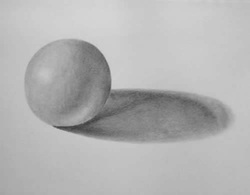Overview
The Elements and Principles of Art and Design are the building blocks used to create a work of art. The Elements can be thought of as the things that make up a painting, drawing, design etc. good or bad - all paintings will contain most of if not all, of the Elements of Art.Discussion
Line: A continuous mark that spans a distance between two points, taking any form along the way (vertical, horizontal, diagonal, zigzag, curved, thick, thin, implied). As a line may be used to define shape in two-dimensional work, a line may also be 3 dimensional, such as wire. Implied line is the path that the viewer’s eye takes as it follows shapes, colors, and form along a path, but may not be continuous or physically connected, such as the line created by a dancer’s arms, torso, and legs when performing an arabesque.

Form: A 3-dimensional shape having volume and thickness (e.g.: cube, pyramid, sphere, cylinder, etc.). It is the illusion of a 3-D effect that can be implied with the use of line or light and shading techniques. Unlike shapes, forms can be viewed from many angles.


Value: The degree of lighting and shade in an image. It is the contrast between black and white and all the tones in between. Value can be used with color as well as black and white. Contrast is the extreme changes between values. Lines and texture can also be used to create value.

Texture: Is about surface quality either tactile or visual. Texture can be real or implied by different uses of media. It is the degree of roughness or smoothness in objects.
Space
Positive space is the objects, elements or images in the composition. Negative space is the area around objects in a composition.









